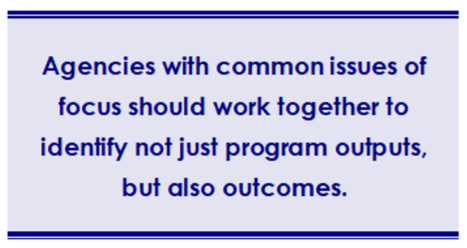You can also view this newsletter as a PDF.

Performance Metrics Needed to Ensure
Accountability for Record State Spending
This year, California saw a record surplus of $97 billion in state coffers, leading to a $300 billion Fiscal Year (FY) 2022-23 budget, including billions in one-time spending to tackle major social issues such as housing and homelessness, climate change, education, inequality, and biodiversity loss. This follows a previous record-breaking $262 billion budget for FY 2021-22. Now comes the hard part – designing and implementing these newly funded programs with consistent use of metrics and oversight to make the most of this massive public investment.
As California moves toward implementation, it is critical that state leaders reinvest in transparency and accountability for these public funds:
- The administration should consider frameworks for assessing capacities and performance of implementing agencies;
- Program managers should collaborate across agencies to develop metrics that measure the outcomes of these investments;
- These same teams should develop platforms for public transparency for all expenditures; and
- The legislature should renew its oversight role in the implementation and success of these programs.
Measuring Capacity and Gauging Success
State government does not have a standardized way of assessing the capacities and performance of the agencies charged with dispatching the work set forth by the legislature. Offices are tasked with assessing their own organizational needs and submitting budget change proposals to request additional funding for specific activities authorized by the legislature, or to propose new program activities not currently authorized.
 The private sector routinely implements organizational performance measurement. For example, many organizations implement a “balanced scorecard” model that provides a periodic assessment of performance and progress toward achieving strategic goals. A few offices across California state government have implemented similar models.
The private sector routinely implements organizational performance measurement. For example, many organizations implement a “balanced scorecard” model that provides a periodic assessment of performance and progress toward achieving strategic goals. A few offices across California state government have implemented similar models.
The Department of Toxic Substances Control launched a strategic planning process to identify and report on key performance indicators. On their website is a dashboard with regular updates on progress toward these indicators. Similarly, the Department of General Services tracks and reports its progress in reducing government’s environmental footprint through Green California.
Consistent performance measurement across agencies would help assess whether specific offices have the capacity to implement their charges. It should become not just best practice, but common practice, to develop and implement these metrics.
Establishing Shared Metrics for Key Goals
As agencies implement the array of individual programs funded through this and last year’s budgets, implementation teams should develop clear program metrics in collaboration with their interagency partners.
Most state programs come with reporting requirements. However, agencies and offices with common issues of focus should work together to identify not just program outputs – how many trees were planted, how many cooling systems were installed, but also outcomes – how many degrees cooler is the average daytime temperature at a given school, how many residents have taken shelter at cooling centers. This will help decision-makers and the public understand the impact of each program and how the programs might combine to bring additional benefit to communities. One example where this model would be beneficial is the state’s focus on extreme heat.
Every year, extreme heat – fueled by climate change – threatens California’s most vulnerable residents. The California Natural Resources Agency has developed a robust action plan focused on concrete actions that can be taken to reduce the risk, improve community services and response, and mitigate harm. The legislature and governor have responded by funding a package of programs spread across multiple state offices. The package includes: $170 million to the Strategic Growth Council to support a grant program for community resilience centers; $75 million to the Office of Planning and Research for a Community Resilience and Extreme Heat Program; $50 million to the California Department of Forestry and Fire Protection supporting an Urban Forestry Program for schools; and $15 million to the Department of Community Services and Development supporting a Farmworker Low-Income Weatherization Program.
The Road Repair and Accountability act of 2017 (Senate Bill 1) provides a useful model in transparency and accountability. SB 1 invested $54 billion in transportation. In its implementation, the state’s transportation agency developed a rigorous set of guidelines including:
- Front-end accountability through “baseline agreements” that establish expected benefits and provide a benchmark for comparison to the current status of the project and the forecast of conditions under a no-build scenario.
- In-progress accountability through ongoing program and project monitoring and review.
- Regular project and program reporting, feeding into annual SB1 updates to the legislature.
- Follow-up accountability, including completion/final delivery reports and audits to help determine if projects achieved their intended outcomes.
Now, the state seeks to align transportation spending with its equity and climate goals. The accountability guidelines above provide a mechanism to build these goals into the outcome measurement.
Earning Public Trust Through Full Transparency
As stewards of the public trust and taxpayer funds, California leaders must continue to provide transparency into how and where funds are spent across the state, and what is accomplished.
The California Cap-and-Trade program provides a valuable model of transparency. Funds from the program support coordinated investments to reduce greenhouse gas emissions, as directed by the legislature. The implementing agencies for these programs must report back on these investments; the data is posted in a dashboard, enabling users to see each funded project and to aggregate data in a variety of ways.
Similarly, the California Health and Human Services Agency has established an open data portal to provide participation data for seven programs, including the California Work Opportunity and Responsibility to Kids Program and the CalFresh food program.
Open FI$Cal now displays expenditure data for a majority of California departments, and SCO continues to enhance tools to help the public look critically at government spending.
Transparency enables the public to better understand how tax dollars are helping their communities, and it strengthens oversight of the programs. It also supports continued improvement and innovation and helps to build linkages with partners in academia, non-governmental organizations, and the private sector to advance initiatives. With a wide array of new programs established through one-time funding, this approach to data should become standard practice.
Renewing Legislative Oversight to Ensure Accountability
Historically, the legislature has played a robust role in accountability for the programs they create. It is critical that the legislature renews this role and keeps careful watch over implementation of taxpayer-funded programs.
California will not always be flush with cash. Should program reductions be necessary, performance management tools can inform these decisions with respect to progress to date toward achieving goals, as well as minimizing adverse and disproportionate impacts. A shared commitment to public service and improving the lives of all California requires policy makers to maximize the value of investments made in times of prosperity, a goal best achieved by implementing performance management mechanisms that ensure accountability for outcomes.
California Faces 'Herculean Effort'
in Move to Gas-Free Car Future
 On August 24, a headline in The New York Times declared, “California to Ban the Sale of New Gasoline Cars.”
On August 24, a headline in The New York Times declared, “California to Ban the Sale of New Gasoline Cars.”
Regulators at the California Air Resources Board (CARB) did, in fact, vote to require that all new cars sold in the state be zero-emission vehicles (ZEV) by 2035, a powerful and necessary step toward meeting federal clean air requirements and the state’s ambitious climate goals.
Passenger vehicles represent 28.5 percent of all greenhouse gas emissions in the state and are a major source of the criteria pollutants choking California’s most vulnerable communities.
The need is clear, and the new ZEV directive seems simple enough, but getting to 100 percent will be a complex undertaking, requiring major intervention from state government. Beyond laying out targets, what is government’s role in reaching the goal, and how can this be done equitably?
Growing the Market for ZEVs
Through the first three quarters of 2022, only 17.7 percent of all new car sales in California were zero-emission vehicles. This was rapid expansion, up 42.7 percent from 2021, but much more needs to be done.
California leaders need to grow the market for new and used electric vehicles. The Governor’s Office of Business and Economic Development (GO-Biz) has developed a Zero-Emission Vehicle Market Development Strategy with four pillars – vehicles, infrastructure, end users, and workforce – and a set of actions state agencies must take in partnership with others to support these pillars and achieve the ZEV goal.
Included in these actions are a variety of tools within state government capacity including regulation, incentives (direct, tax relief, loans), and education and outreach.
Key among the state actors is CARB, which has recently adopted the Advanced Clean Cars II regulation, drawing the boundaries of what types of cars manufacturers will be able to sell into California after 2035. CARB also has two major incentive programs to support this transition: the Clean Vehicle Rebate Program, which offers rebates for the purchase or lease of new vehicles; and Clean Cars 4 All, which provides incentives for lower-income drivers to exchange older, more polluting cars for zero-emission vehicles.
Increasing Production of ZEVs
To meet the demand for electric vehicles, car manufacturers will need to significantly ramp up their production. This will require technological innovation and development; a strong, reliable, and climate-responsible supply chain for minerals and materials; and workforce development and training. California does not have much leverage in this policy area. However, at the federal level, the Inflation Reduction Act has channeled billions of dollars into programs to support clean tech manufacturing. This includes provisions to help build out domestic supply chains for these vehicles, and to ensure a trained and supported workforce. For its part, California has supported electric vehicle-related businesses through a variety of tax incentives and loans, in addition to offering business assistance through GO-Biz and the California Workforce Development Board.
Growing Charging Infrastructure
To support this growing fleet of electric vehicles, the state will need to increase deployment of charging infrastructure and ensure this infrastructure is commonly accessible and distributed equitably across California. Despite meaningful investments through the California Energy Commission’s (CEC) Clean Transportation Program, only 79,000 chargers have been installed. Beyond funding, meeting state’s goal of 250,000 chargers and 10,000 fast chargers by 2025 will require the coordinated efforts of state and local government entities. It will require changes to building standards, a review of electricity rate design at utilities, permitting at the local government level, and many other administrative measures.
 Protecting Grid Reliability
Protecting Grid Reliability
As ZEV adoption accelerates, California must continue its push to 100-percent clean power while maintaining grid reliability. The CEC, California Public Utilities Commission, and California Independent System Operator all bear some responsibility for achieving a clean, reliable electricity infrastructure. These entities will need to work together to track and manage changing demand related to electric vehicles. In addition, they will need to develop a system of incentives and regulations to encourage and manage the integration of electric car batteries as storage on the grid.
Transition to ZEVs: Other Considerations
As the market for ZEVs grows, there will be a range of secondary impacts to manage. Thoughtful approaches will need to be developed to manage the inventory of gas-powered vehicles still in the hands of car dealers, rental agencies, and consumers, as well as the resale of ZEVs. There must be consideration for economically feasible ways to phase down gas stations and other service establishments for gas-powered cars and address underground storage tanks. California must develop infrastructure around the recycling of car batteries. The list goes on.
Moving Beyond Cars
Even as California moves toward an all-electric future, it is important to recognize that the simplest way to reduce to transportation-related pollution is to drive less. Efforts to increase reliance on zero-emission vehicles must be paired with equitable and accessible multi-modal transportation and thoughtful community design. California must continue to push forward policies and programs that increase transportation access, accelerate infill development, and align land use planning with climate goals.
Ensuring Accountability
Through the Zero-Emission Vehicle Market Development Strategy, GO-Biz and the Administration have committed to transparency and accountability. Development of a ZEV portal and suite of metrics will give state leaders the tools needed to track progress and improve policies and practices. Each state agency responsible for actions within the plan also will be required to report annually on its progress. Accountability is critical to adaptively managing this challenge.
Behind a simple headline – “California to Ban the Sale of New Gasoline Cars” – remains a herculean effort to help push a major industry toward a climate-friendly future. All parts of government will need to play an active role that must include engaging all stakeholders affected by the transition to, production of, and support of ZEVs, as well as by the expansion of multi-modal transportation and infill development.